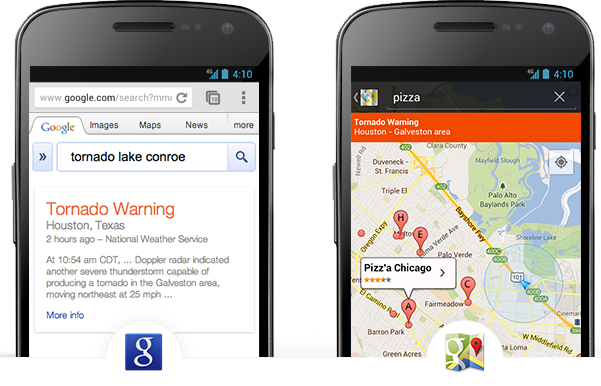Immediately after the Kaikoura earthquake, media were reporting a tsunami evacuation alert/order. Many Wellingtonians left for higher ground on foot or by car in the early hours of the morning. But there was confusion about the evacuation zones and the state of the alerts, which became a controversy in itself.
It’s a big issue- how can the public be notified about an emergency alert, especially if they are asleep or in a remote area. What if people at risk are tourists, elderly, infirm, non-english speakers?

I think there are some important opportunities being missed in the latest response, and this article explains my view on them. These key points are:
- we are still not clear on how to effectively communicate with the public in an emergency
- there needs to be a central source of emergency alert information in real-time available, including a public API
- while mass-texts are good, we can also very cheaply share these alerts online through Google and other app developers
- the regional structure of civil defence offices can cause confusion and some communications centralisation will be valuable
- some current resources are not being made available to the public in an effective manner, this includes evacuation zones and common communication tools (e.g. tsunami threat map that is commonly used)
Technology offers a range of tools that we can offer. Government’s initial response to concerns was to announce that they are progressing plans in establishing an emergency SMS broadcast system, enabling every switched on cellphone to receive an alert. There’s also an established array of regional Facebook pages, and local civil defence websites to disseminate advice while the most prominent channel at present is the media through radio, tv and news sites.
First, what are successful public communications in an emergency? We are a long way from understanding the public needs to know to respond effectively
Considering the context of an emergency event, it is easy to forget the challenge of giving clear information. This information is highly urgent, often based on a scientist’s judgement call and subject to change as new facts come to light. Agencies have to balance their duty to preserve life with the reality of being pilloried if they get it wrong. Tsunami alerts are regularly generated based on global earthquakes. A friend and civil defence volunteer Nigel McNie observed that there is scope to fund research and continued evaluation of what the wider public communications needs are, not just funding the platforms to distribute these messages. Earthquakes are different from tsunamis, which are different from major transport disasters, biosecurity alerts or floods. Agencies need to carefully consider how prepared they are to broadcast appropriately and look to support research in discovering that understanding. I couldn’t express it better than my friend Nigel McNie’s comment to me: ‘…I’d find the best [user experience researcher] I could, lock them in a room with Civil Defence and slide pizza under the door until they understood how CD thinks they operate. Then I’d have them interview a thousand people about their behaviour in disasters. And then, maybe, we’d have enough information to model this problem accurately enough that we could save the lives we need to… At least the “if it’s long and strong, get gone” message is a seemingly reasonable baseline. Many people can understand it, and it’s better than nothing.’
We need to improve the technical standards of what alerts are issued and how the public should respond.
In an emergency it is surprisingly challenging to communicate an alert clearly. For example new information is discovered over time and impacts people in different ways. So we will report an alert, that indeed an alert is confirmed for this region, that the alert now applies to neighbouring regions (who earlier were not covered by the alert range) all within minutes of the previous notice. Subsequently we announce that the alert is now in the past and people can return. In practice all of these single announcements are repeated and begin to contradict each other as old news is repeated. Officials say ‘return home’ while friends on Facebook shout ‘run for the hills!’
The other thing is that all emergencies are unique so there is always the chance of surprising information. A system designed for a tsunami alert might struggle to respond to an explosion or closing a city centre post-quake. There’s also the challenge of alert fatigue – where warnings are commonly issued but not often relevant to the recipient.
See Mediawatch discussion of the challenges reporting information without a clear status being available.
A public API needs to be made available on any significant alert

A key piece missing from previous alert notifications is that there needs to be a well-structured alert format. This needs to be open for developers to subscribe to. I’ve discovered that agencies are advancing in complying with the CAP format which is positive (but let’s face it, many years overdue).
I hope this work will deliver a unified national alerts website, that anyone can source an advisory from.
APIs aren’t solely about allowing development of alerts within apps. A documented API would force alerts to be issued that have an agreed structure of key information and avoid circulation of confused, garbled, incomplete or wrong information. If a computer can automatically process an alert, this enables immediate distribution on your news website, while you’re Facebook sharing or on a weather app. In a confusing moment, provision of authoritative instructions is invaluable and provides the basis for individuals to respond to their own situation. It’s a good goal.
An open, documented API would give media an authoritative source of all key aspects of clear communication, including:
- the acuity of an alert (whether this is a general warning or a serious notification relating to your safety)
- the status of an alert at present, including clarity if it has changed and knowing when that alert is still unconfirmed, cancelled or rescinded
- instructions to the public – clear and simple statements
- the location where an alert is relevant, providing the potential for alerts to be targeted but at minimum reducing confusion about who is affected
Civil Defence has selected the Red Cross developed app that citizens can subscribe to but this doesn’t address my concern. The public API would allow any application to notify its users of an alert and the public could choose where to receive this information.
Just to restate the benefits. Structured alerts mean communications are more likely to give clear and effective information. The agreed authoritative alert will be essentially able to be shared in real-time anywhere.
Emergency APIs at Google, Facebook et. al are valuable resources and NZ agencies could participate more
An investment in text message alerts is valuable due to the potential to get a message broadcast en masse. SMS messages don’t strain phone networks like calls inherently do. So it’s feasible to send everyone in say, Auckland, a text message in an extreme scenario. This makes sense and I think it should be progressed.
This thinking can be extended to where internet browsing is occurring, and is also where people will go after a short alert to get a clearer picture of the situation. Google Alerts offers government agencies an API to notify them of civil emergencies and this will be a valuable way to notify more people who are using search and apps in their daily lives. This investment doesn’t cost much, and only provides value. And in writing this article, I discovered that Geonet is integrated to them for earthquake alerts – so big ups to the seismologists!
These APIs are a follow-on from Google.org’s non-profit contribution to emergency awareness. I’m not as clear on Facebook’s policy but these behemoth platforms offer the opportunity to achieve communications goals at low cost to the agencies. They are where the eyeballs are. We go to these platforms to get information on our traffic jams, but there’s still no certainty that an emergency notification will be shared.
They also are one more system that is unlikely to crash and provide another channel to circulate information.
This is not the same as local Civil Defence offices operating Facebook pages. These pages deliver a lot of value, and provide a channel for general education and resilience initiatives as well as hugely relevant local advice. But they don’t offer the benefits of the emergency APIs.
Consider the option to centralise 1 national Civil Defence public advice portal to reduce confusion about broadcasts
Were you in Waikanae and wondering about the tsunami alert? How about Wanganui or New Plymouth? I observed a number of regional Facebook pages getting inquiries about other regions and that these administrators didn’t have access to that information, and no portal to refer people to. This reflects the local office structure through which civil defence is organised.
In a recent earthquake in Wellington, the local civil defence website went down due to a power failure in the building it was hosted in. Each response office operates their own website that will predictably go down under the load of a crisis. These sites are not necessarily well developed as they’re generally created by small teams who are not experts in technology or public communications – they’re experts in preserving public safety and coordinating physical initiatives on the ground.
Plan for digital failure – for example publish evacuation zones as Google/OSM Maps as an example fallback
I had an uncomfortable moment the day after the earthquake. I wanted to check the tsunami zone that our new office was located in (we’re on The Terrace, Wellington). Sitting in my office, I looked for 10-15 minutes to try to locate this information and it was displayed in a barely legible PDF. In an emergency situation, we should all be going to higher ground rather than surfing websites but we can do better to have people be well informed.
Realistically people will go online to investigate their situation, and we can be better prepared at meeting their needs.
Wellington’s Emergency Management Office has published their tsunami zone levels information on Koordinates, which is a great option for other regions to pay attention to although it would be good if these are intended to be highly-available or to be downloaded by other websites.
Being prepared gives peace of mind. A reminder to take responsibility for yourself and family
I just want to add that one thing everyone can do is make some practical plans and not rely on civil defence’s stretched resources. After the Christchurch earthquake my family made a rendezvous plan and stored some water and tinned food. Previously I had no preparation.
It’s everyone’s responsibility to look after their own basics of resilience and you feel a lot better knowing that you have some backup plan.
Emergency response agencies need to prepare for very serious events and can potentially save lives in an emergency. At present, it is clear that there is much that can be improved and I’m cheering on those doing the hard work of planning to improve these systems. Hopefully the improvements underway in our national infrastructure will make a big difference in our response to a future major crisis.
I also want to make clear that I am not involved in the civil defence agencies beyond some occasional voluntary conversations and appreciate that these organisations operate with very constrained budgets (something that I think should change).
I also want to mention the small team of technologists who volunteered in the recent Civil Defence simulation Operation Tangaroa. I admire their generosity to our national agencies.
Thanks for giving me comments – Nigel McNie, Josh McArthur, Richard Clark, Diogo Friere, Tim McNamara
References and further reading:
http://www.radionz.co.nz/news/political/318584/civil-defence’s-earthquake-response-to-be-reviewed
http://www.radionz.co.nz/news/national/318473/govt-to-push-for-tsumani-text-message-system
Geonet blog: http://info.geonet.org.nz/pages/viewpage.action?pageId=20545630
http://info.geonet.org.nz/display/home/2015/11/30/GeoNet+Supports+Google+Public+Alerts+for+Quakes
http://www.civildefence.govt.nz/assets/Uploads/CDEM-Resilience-Fund/2016-17/2016-18.pdf
http://www.radionz.co.nz/national/programmes/mediawatch/audio/201824321/shaken-into-action
http://www.stuff.co.nz/business/farming/88037987/new-app-sharpens-earthquake-response-to-help-farmers
http://www.sunlive.co.nz/news/143041-crying-wolf-tsunami-warnings.html
http://www.radionz.co.nz/national/programmes/saturday/audio/201826327/kevin-furlong






